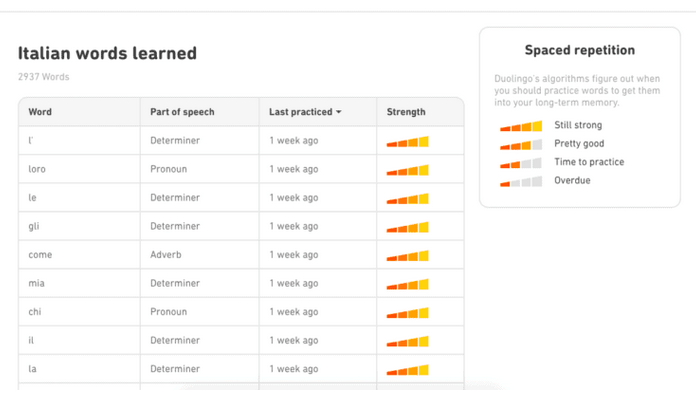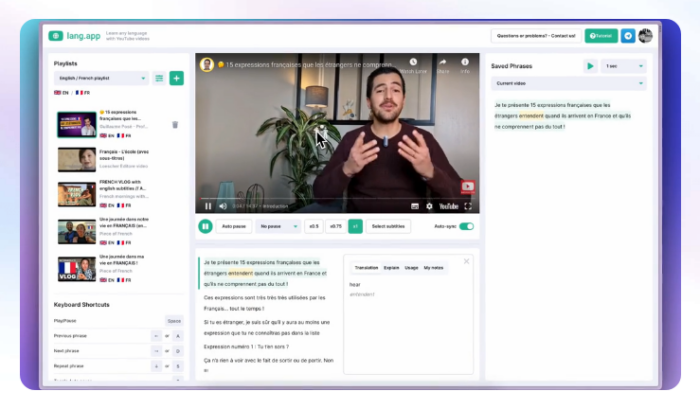5 Reasons Why You Haven’t Mastered Your Foreign Language
Read other articles:
Back to posts
Table of Contents
- 1 1. You’re using the wrong foreign language-learning method
- 2 2. You’re not relaxed
- 3 3. You’ve “put away childish things”
- 4 4. You’re using the wrong foreign language-learning apps
- 5 5. You’re not engaging with native speakers
- 6 6. Start mastering your foreign language
- 7 7. How to use video to master your language
All is not lost if you feel frustrated at “treading water” with your French, Italian or Spanish learning.
Many dedicated and highly motivated adult foreign language students get to a certain point where they feel their learning is going nowhere. It kind of “plateaus out” and it’s difficult to take the step up to really master the language.
They know enough to “get by”, converse, read and write a little but achieving near-native-speaker level seems like an impossible dream.
What’s stopping them?
Here, we take a look at the five most common reasons why foreign language learners stall with their progress, causing many to move on to other things and admit defeat.
That’s a big mistake after putting so much effort into your language learning. Understanding the reasons why you haven’t mastered the language yet can help reinvigorate your learning and inspire you to have another crack at taking that all-important step up…
1. You’re using the wrong foreign language-learning method

Not everyone learns the same way and not all languages are learnable at the same pace. Learners and languages are different and studies suggest that some learners can learn quicker because their brains are “wired” differently — for instance, a strong phonological memory can speed up language learning according to this study.
How do you know the language-learning style that best suits you?
Many people who learn a language independently use a variety of methods before opting for one they’re most comfortable with according to their preferred learning style, needs and main objectives.
We’ve found that some methods of learning languages are more effective than others. Serious learners need to go beyond the traditional grammar-translation method, which is widely employed in language apps, classes and online courses.
Instead, consider the benefits of learning by immersion in the language and through storytelling. Constant exposure to the target language helps you naturally acquire it over time and stories provide context, increase engagement and aid recall.
These methods are generally more effective than memorizing grammar rules and vocabulary, which remain the basis of many teaching methods despite evidence indicating that they are inefficient.
2. You’re not relaxed

The learning environment and stress levels you’re exposed to when learning a language are also important.
One of the main requirements for learning a foreign language successfully, according to language-learning guru Stephen Krashen, is a low-anxiety environment.
Language should be a fun and relaxed experience, not something you dread. Many adult learners remember bad experiences learning languages in school: strict teachers, dumb answers to questions, other kids laughing at your accent or being shamed in front of an entire class, etc.
Unfortunately, some language class situations still place adult learners in high-stress situations where they must speak the target language on-demand (for instance, when using flashcards).
Some people thrive on the pressure but, for many, the instinct is to “clam up” and this will prevent active language learning.
Removing any foreign language anxiety and trying to make learning more enjoyable and engaging should get better results.
3. You’ve “put away childish things”

“When I became a man, I put away childish things”
(Corinthians 13)
Adults may not have the “sponge-like” brain for learning that children have but it’s a mistake to completely “put away childish things” when we learn.
In fact, we can learn a lot from children. Not only in how they learn but in how they have fun!
Often, we adults take things far too seriously. We must learn this language or that language and must do it by this date or that date. Kids just absorb languages naturally and, when they’re ready to speak it, they will.
Kids learn most effectively when they’re relaxed and having fun. We all remember French or German lessons as children when we were made to memorize vocab in class; this wasn’t fun and few students made much progress because it felt like a chore or just too boring.
Contrast this with those children who were fortunate enough to go on holidays overseas with their families. They would learn phrases in context, in a fun environment and with immersion in the local culture. Phrases would “stick” much easier and those children became more confident in using the target language.
Some adult learners might need to take a trip back to their childhood to make learning their target language more effective by making it more fun and engaging.
Not everyone can arrange a foreign holiday but we can gamify the learning experience or at least use the tools available to make it more interesting.
Ultimately, to learn a foreign language more “naturally”, we need to stop using the conventional methods of conscious learning and start using more subconscious methods — as children do.
4. You’re using the wrong foreign language-learning apps

Having said that adults are disadvantaged over children when learning a second language, we do have some distinct advantages too. For instance, adults usually have more patience, more experience of learning, greater motivation, fewer distractions and wider access to technology.
On the last point, foreign language learning has received a huge boost in the last 10-15 years with the number of language learning apps available.
There’s plenty of hype about these apps and some of it is with good reason. But consider a journey where you want to go from A to B and taking a slow bus means the trip takes five hours while a quick bus takes just two hours.
Changing the interior décor of the slow bus won’t get you there any quicker — though it may make the journey seem more comfortable.
Let’s say “A” is moderate language proficiency and “B” is native speaker level. To get to B quicker, you need to change the vehicle (the method of learning) rather than the interior décor of the bus (an app instead of a textbook).
The point is that many language apps use the traditional grammar-translation method of language learning, which is unengaging and highly inefficient.
Researchers have found that a major downfall of the majority of language apps is a rigid focus on teaching vocabulary units in “isolated chunks.” The lack of context inhibits learning.
Language apps may be easy to download, free or cheap to use and dress up the language learning process in fancy colors but ultimately, they don’t help serious learners to take the step up.
For a language learning app that does get you there quicker (because it encourages and facilitates a more natural language acquisition method) read on for more information about LangMagic…
5. You’re not engaging with native speakers

Consider again how a child learns (or “acquires”) a native language. Children are immersed with native speakers and practice listening for a long time (usually around a year) before they start speaking.
During the first year of listening, a database of images or symbols associated with objects, feelings or actions is being formed in the child’s brain. The child learns the sounds and contexts in which to use the database.
If language learners can surround themselves with native speakers and listen more, they can acquire language more naturally and effectively, engaging not only the conscious learning centers of their brains but also the subconscious centers, where deeper learning occurs.
Native speakers of the target language can usually be found both online and offline — from local neighborhoods to Facebook groups, online language exchanges, apps and browser extensions.
Each language forms part of a wider culture. In the absence of face-to-face communication with native speakers, exposure to movies, TV programs, videos and music can provide important context for the target language.
Greater “immersion” in the language is often what students who have plateaued in their learning are missing. The tools are there now to achieve much greater exposure to native speakers and give your listening and your learning a huge push.
6. Start mastering your foreign language

Only a tiny fraction of the estimated 1.5 billion people learning a second language globally ever reach more than a basic proficiency level.
Let’s assume you have the necessary motivation to learn a foreign language but you’ve plateaued out. One of the above reasons has likely contributed to your perceived “failure”.
The good news is that almost all foreign language learners go through the same experience at some point. You may simply need to tweak the way you’re trying to learn — and video is the single biggest advantage you have in this respect.
7. How to use video to master your language
The rise of artificial intelligence and the huge library of captioned video content from around the world has opened up so many possibilities for language learning.
YouTube, Netflix and other video platforms combine with AI tools like Chat GPT so that practically anyone can learn practically any language simply by being online with the right tools.
Ramp up your language learning now through video by downloading our free and simple Chrome extension. It helps you build a library of new phrases as you learn from native video in context with explanations and prompts.
This may be what’s been missing as you strive to take that next step up in your language learning.
Read other articles:
Back to posts
